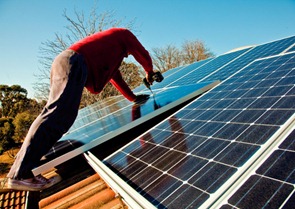Market Risks are Seen in Energy Innovations
by Matthew L. Wald, NEW YORK TIMES, September 15, 2011
 The same market forces that doomed Solyndra, the solar cell manufacturer that received $528 million in government loans and then went bankrupt, could imperil other manufacturing ventures that have received loan guarantees from the Energy Department, energy experts warned this week.
The same market forces that doomed Solyndra, the solar cell manufacturer that received $528 million in government loans and then went bankrupt, could imperil other manufacturing ventures that have received loan guarantees from the Energy Department, energy experts warned this week.
The problem is that even if a company with a cutting-edge technology manages to build a factory on time and at the anticipated cost, the market price of its product can collapse before its rollout, they said. That is what happened to Solyndra and its solar power arrays, experts say, as the supply of solar panels from other factories increased and demand lagged.
Administration officials acknowledge that the market creates risks that loan guarantees will not be repaid. But they emphasize that the loan program’s purpose is to take risks so that it can help important new industries incubate.
Not all of the loans are so risky. Energy Department officials told a House subcommittee looking into the bankruptcy on Wednesday that the loan guarantees for power-generation ventures like wind and solar farms tend to be safer. Before a power generation loan is approved and the equipment is readied, Jonathan Silver, the head of the Energy Department’s loan program office, testified, the electricity is contracted for by utilities.
That guarantees an income stream, he said. While factories may have a few orders in hand, they generally cannot sell years of future production before they break ground.
The Department of Energy has guaranteed loans of nearly $2.5 billion to companies that will make electric cars, a product whose market size is uncertain. Some analysts have concluded lately that there may be an oversupply of some components.
“Based on the production capacity that’s been announced or planned, we expect there to be more batteries than there are vehicles to put them in,” said Kevin C. See, an analyst at Lux Research, which predicts substantial consolidation among the would-be manufacturers in the months or years ahead.
While the market for Solyndra’s product, solar cells, is gaining in maturity and is somewhat predictable, the market for electric cars is less certain, analysts add.
“In the case of manufacturing electric vehicles or batteries for electric vehicles, it’s basically speculation as to whether you think they’re going to have customers, ‘’ Mr. See said. Another analytical firm, Bloomberg New Energy Finance, reached a similar conclusion last week, saying that the manufacturing capacity for specialized lithium-ion batteries will greatly exceed the need “unless demand by automakers increases significantly in the short term.”
Battery prices are “poised to fall,” Bloomberg said, just as a decline in solar panel prices hit Solyndra.
Nissan North America has a loan guarantee of up to $1.448 billion for retooling a factory in Smyrna, Tenn., and building the Nissan Leaf, including the battery. In a telephone interview on Friday, Mr. Silver of the Energy Department said that the company, a “triple-B-plus investment-grade company, has the wherewithal to ensure repayment” even if electric vehicle sales prove to be weak.
Mr. Silver said that the Energy Department’s loan guarantee program was supposed to take some risks. “Congress directed us to identify technologies that could be brought to market in an effort to leapfrog the United States forward and re-establish innovation leadership,” he said. “ Our job is to identify those technologies and build them out.”
A company spokeswoman for Nissan, Katherine Zachary, said that the Leaf was “selling great,” although total deliveries so far total only about 6,100. “If we had more, we’d sell more,” she said.
Fisker Automotive got $529 million to develop and build two kinds of plug-in hybrid electric vehicles at a factory in Wilmington, Del. Tesla Motors got $465 million to reopen a factory in Fremont, Calif., to produce all-electric vehicles and to make battery packs, electric motors and other components. They both buy batteries from other suppliers, but their success depends on an electric vehicle market.
Adding another layer of uncertainty, experts say, electric car sales rely heavily on inducements to consumers by state and federal governments, and in an era of budget-cutting, it is not clear how generous the governments will continue to be. [Read rest of article]


